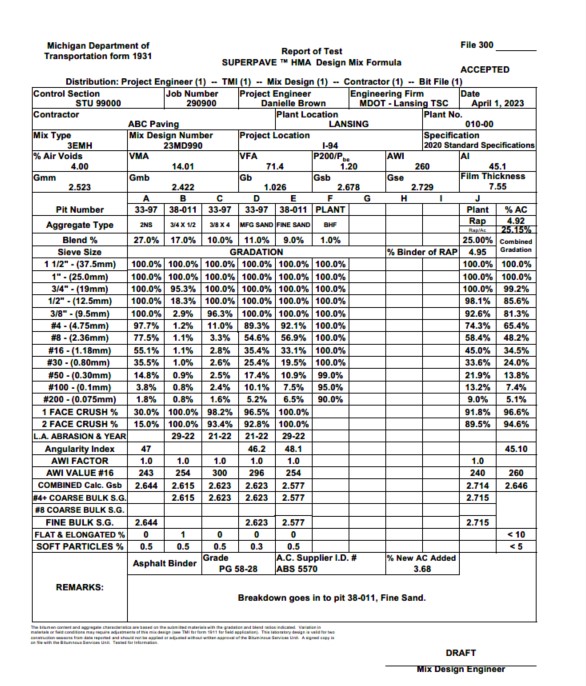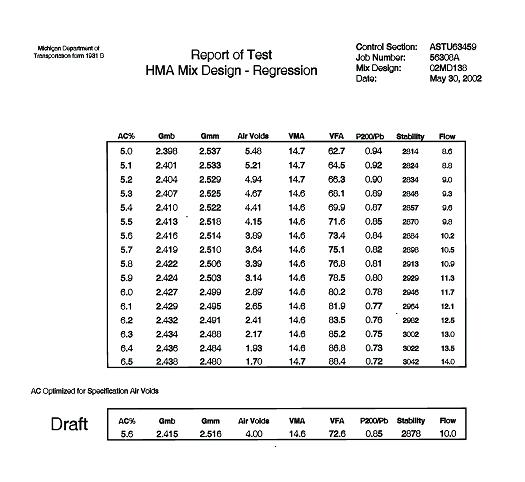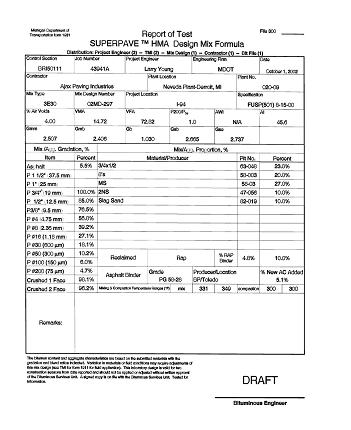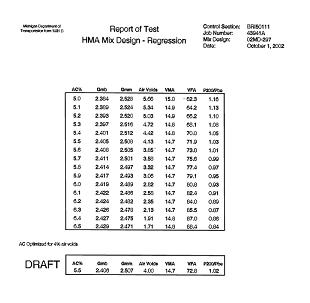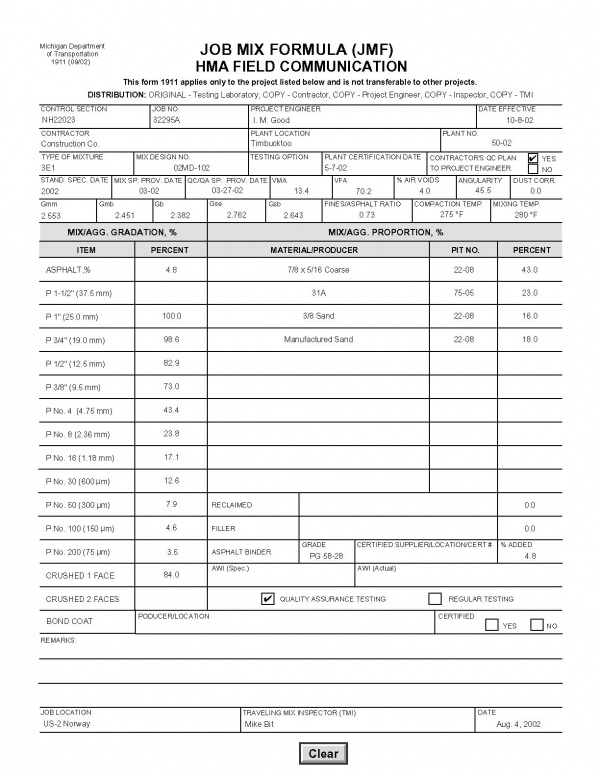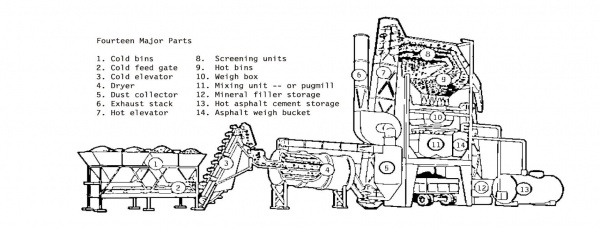501 - Plant Produced Hot Mix Asphalt
GENERAL
Pre-Production Meeting
A pre-production meeting should be held before work commences on a project. During this meeting, the overall goals and expectations are set for the project. It is generally the responsibility of the Engineer to outline the scope of the project and to discuss the information provided in the contract documents. It is also the responsibility of MDOT and the Contractor to discuss any unusual aspects of the project, items that are not routine construction practices.
The role of each person on the project, for both MDOT and the Contractor, should be discussed and made clear. This requires that the supervisory personnel define the tasks, authority and responsibilities of each of the key individuals to be involved in the work. A list of MDOT personnel who will be assigned to the project should be provided to the Contractor.
The Contractor’s representative should be familiar with the project and be able to speak with authority about what is to be accomplished. A paving schedule for the project should be presented and discussed with MDOT. Any questions about the information in the contract documents should be raised and clarification requested, if necessary. A listing of key Contractor personnel who will be assigned to the project, with clear lines of authority, should be provided to MDOT.
Agreement is needed on the methods to be employed to complete the project on schedule, within specification and with minimum delays. A list of equipment that will be used on the project should be supplied to MDOT. Because continuity of the asphalt paving operation is critical to providing a quality pavement, the discussion between MDOT and the Contractor personnel should include such items as those listed below.
The discussion should include the safety of those individuals working on the project, as well as the safety of the traveling public. Clear responsibility for maintenance of all traffic control devices, such as signs, pavement markings and flagging, should also be defined.
The name of the individual responsible for safety for the Contractor should be provided to MDOT so that rapid and clear communications can be accomplished if safety problems occur. All personnel involved in the project must be required to comply with all safety standards applicable to the type of construction and asphalt paving work to be carried out.
Sampling methods and frequencies should be discussed. Test methods to be used should be reviewed to assure that individuals understand the purpose of each test, the location of the field lab and the personnel who are to conduct the tests, the time frame for the communication of the test results and the procedures to be used if failing test results are obtained. The details of the quality control program, both on the part of the Contractor and MDOT, should be discussed so that everyone is aware of who is responsible for performing the procedures and when they will be done.
Communication cannot stop once the pre-production meeting is concluded. It is important that the individuals in daily charge of the project for both MDOT and the Contractor meet periodically, both on a formal and informal basis, to discuss the progress and quality of the work done to date and the progress schedule for the future. Ideally, these meetings should occur at a regularly scheduled time and can be held on the project site, or at the asphalt plant. Asphalt paving projects, like many construction projects, are not always built as originally scheduled. Changes occur because of material supply, equipment breakdown, Contractor and Subcontractor schedules and weather conditions. When such changes do occur, it is important that they be communicated between the Contractor and MDOT and between MDOT and the Contractor.
|
| |
|---|---|
|
|
Project safety. |
|
|
Project mixture and testing Special Provisions. |
|
|
Job mix formula. |
|
|
Job mix formula adjustments, retroactive. |
|
|
Lot and sublot size. |
|
|
Random numbers. |
|
|
Sampling procedures. |
|
|
Laying out core locations and traffic control for coring. |
|
|
Laying out core locations, discuss how it will be done. |
|
|
Trial runs. |
|
|
Sequence of operations. |
|
|
Paving widths. |
|
|
Equipment required. |
|
|
Application rate of materials. |
|
|
Plant production and paver speed. |
|
|
Mixture temperature at the paver. |
|
|
Pavement density control, roller patterns. |
|
|
Weather and air temperature requirements. |
|
|
Project documentation. |
Safety
HMA mixtures consist of a blend of asphalt binder and aggregates mixed in an asphalt plant. When specified, special additives may be required.
The old saying “Safety is Everyone’s Business” is certainly true on an HMA paving project. Communication is one of the keys to a safe work environment. Every individual should know what is expected and know how to perform the assigned tasks. Everyone, regardless of title or job function, must be aware of the need for safe work practices. Occupational Safety and Health Administration regulations must be known, understood and followed by each person involved on the project. Safety talks are a very good way to start each day for both the Contractor and MDOT personnel. Several different organizations publish short, concise safety presentations that can be completed in two to three minutes. Daily talks are one way to continuously remind people that they are working in a potentially dangerous environment at both the plant and the paving site. If an unsafe work practice is noticed, corrective action should be taken immediately, even if the paving operation has to be shut down until the unsafe practice is corrected.
The people most likely to be hurt on an asphalt paving project are those individuals who are new to this type of work. A new plant inspector can easily get burned if not aware that asphalt samples are very hot. Functioning equipment parts, high temperatures, noise and moving delivery and haul trucks all add to the possibility of an accident occurring.
The street inspector can easily get hurt if they are not aware of the number of vehicles operating on the paving site. Individuals who are working around the paver are susceptible to being hit by passing traffic and have the potential to be hurt by the equipment being used in the paving operation.
Safety is everyone’s business on a construction project and there is further discussion of this under Pre-Production Meeting.
Glossary of Paving Terminology
- AGGREGATE - Various hard, inert materials such as sand, gravel, pebbles, etc., used as the bulk material in asphaltic mixes.
- ANGLE OF ATTACK - The angle incurred between the screed plate and the surface.
- ASPHALT - A mixture of bitumen (bonding agent) and aggregate (bulk material).
- AUGER - A rotating device with a broad, helical flange (flighting) used to spread paving material evenly in front of the screed.
- AUGER SHADOWS - Alternate dark and light areas of compaction occurring longitudinally in the mat, representing different density and texture.
- AUTOMATIC FEED CONTROLS - The standard system for maintaining a constant head of material in front of the screed by controlling the ON - OFF operation of the unit’s dual feed system.
- AUTOMATIC GRADE AND SLOPE CONTROLS - The electronic/hydraulic control system that automatically maintains the elevation of one screed tow point with respect to a reference surface (grade), while maintaining the elevation of the opposite screed tow point in relation to the first with respect to gravity (slope). It is used to improve upon the levelability of the paver.
- AUTOMATIC LEVEL CONTROL (Joint Matcher) - An electronic/hydraulic control system that automatically controls the elevation of the mat being placed on one side with respect to a reference surface such as an adjacent mat or cut. It is used to match the profile of the edge of a mat to that of the adjacent surface.
- BITUMEN - A thick, viscous, petroleum-based substance used as bonding agent in asphaltic mixes.
- BURNERS - See SCREED HEATERS.
- COMPACTION - The process of increasing the density of paving material.
- CONVEYOR - An endless chain and bar assembly used to move paving material from the hopper to the auger.
- CORRUGATION - Washboard effect usually occurring in areas where braking and acceleration take place. It may also occur to a lesser degree in the even speed areas. It is caused by an excessively soft mix over an unstable base.
- CRACKS -
- ALLIGATOR - Crisscross cracks usually due to heavy traffic loads exceeding the strength of the surface over an unstable base.
- LONGITUDINAL - Cracks that appear along longitudinal joints, between lanes and shoulders, and many times at the base and outer edges of ruts. These cracks result from movement along these weakened areas.
- REFLECTION - Existing cracks in sub-pavement, eventually coming through an overlay, due to continued movement in the unstabilized sub-pavement.
- SHRINKAGE - Random cracks appearing due to lack of traffic that would normally keep the surface sealed.
- SLIPPAGE - Cracks appearing in the overlay because the surface is pushed or rolled apart by breaking traffic. This may also occur if an overlay is poorly bonded to the sub-pavement due to inadequate tack coating or improper mix design.
- TRANSVERSE - Cracks perpendicular to traffic flow. In overlays of concrete, the concrete joints may reflect through surface if movement occurs along the joint. Concrete stress cracks across the pavement may also reflect through.
- CROSS BEAM - A steel bar connected between the side arms for mounting the slope sensor.
- CROWN - The transverse contour of a finished mat. Also used to describe the contour of the screed plate. The transition line between two different slopes (i.e., between lanes or between lanes and shoulders).
- LEAD CROWN - The contour or profile from side to side of the leading edge of the screed.
- TAIL (or ROAD) CROWN - The contour of the trailing edge of the screed.
- NEGATIVE CROWN - Contour that is higher at the edges than at the center of a mat.
- POSITIVE CROWN - Contour that is higher at the center than at the edges of a mat.
- CUT-OFF SHOE - A detachable plate used to reduce the paving width of a screed.
- DENSITY - Measurement of in-place pavement compaction.
- DEPTH CRANK - Adjusting crank located at the rear of each side arm, used to control angle of attack of the screed.
- EDGER PLATE - A vertical plate at each end of the screed used to confine the head of material.
- ELEVATION - Vertical height from a reference surface.
- FEEDERS - L. H. and R. H. auger-conveyor systems on a paving machine.
- FLOATING BEAM - An aluminum beam, supported by a series of spring loaded shoes, towed beside the paver and used as a reference.
- FLOW GATES - Adjustable plates at the rear of the hopper used to control material volume conveyed to the augers.
- FLOOR PLATE - A heavy steel plate upon which the conveyors travel.
- FREE-FLOATING SCREED - The screed is supported on the surface of the paving material as it passes beneath the screed plate. Material thickness under the screed will increase or decrease according to the angle between the screed plate and grade surface.
- GRADE -
- The base surface (road bed) over which paving is being performed.
- The elevation of a fresh mat in relation to the base.
- The incline of a paving surface in the direction of travel, expressed by stating the rise or fall as a percentage of horizontal distance. (Example: 6 percent grade - 6 inches (6 m) of elevation change in 100 feet (100 m) of horizontal longitudinal run).
- GRADE CONTROL - A means of controlling the longitudinal elevation of a mat as it is being laid.
- GRADE SENSOR - An electrical device that detects positive and negative changes in longitudinal elevation from a grade reference (i.e., wire or string line, floating beam, mat reference, adjacent mat, or curb surface).
- HEAD OF MATERIAL - The volume of paving material directly in front of and along the entire lateral length of the screed.
- HMA - A paving material that consists of asphalt binder and mineral aggregate.
- HOPPER - The area at the front of the paving machine that receives the paving material.
- HYDRAULIC - Liquid in motion under pressure, the flow of which causes work to be accomplished.
- HYDROSTATIC TRANSMISSION - Power transmitted by a positive displacement pump through a liquid under pressure to a positive displacement motor.
- INCLINOMETER - See SLOPE SENSOR.
- JOINT - The point at which a new asphalt mat connects with one previously laid.
- LATERAL or TRANSVERSE JOINT - A joint perpendicular to the direction of travel (i.e., night joint).
- LONGITUDINAL JOINT - A joint parallel to the direction of travel (i.e., a joint between two "lanes" or between road and shoulder).
- TRANSVERSE JOINT - A joint perpendicular to the direction of travel.
- JOINT MATCHER - See AUTOMATIC LEVEL CONTROL.
- LIFT - Another term for “mat”, usually used in conjunction with a thickness, such as “a 6 inch (150 mm) mat was laid in [3] 2 inch (50 mm) lifts”.
- LINE OF SHEAR - The lateral line of contact in the paving material at the leading edge of the screed pre-strike-off where material divides to pass beneath the screed plate or move upward along the face of the screed into the augered material for later placement.
- MAT - The material being placed by a paver/finisher.
- MAT REFERENCE SYSTEM - An aluminum beam, supported by a series of spring loaded road wheels, which is towed behind the screed. It is used in conjunction with the Floating Beam to permit taking 50 percent of the longitudinal grade reference from the freshly laid mat and combining it with the average taken from the existing grade to produce the ultimate in a smooth riding surface.
- NULL - A condition that exists when components are at rest.
- “NULLED” SCREED - A screed resting flat on the mat and having no angle of attack.
- “NULLED” GRADE AND SLOPE SENSOR - Sensors that are operating, however, they are transmitting no signal.
- PIVOT POINT (of screed) - The pin mounting point of the screed frame on the rear of the side arm.
- POT HOLES - Local base failure causes a pocket that further deteriorates due to containment of water as the surface collapses. Traffic bounces the broken surface out, exposing intermediate and base materials to more moisture and the abrasion of traffic.
- PULL POINTS - See TOW POINTS.
- PUSH ROLLER - Rollers mounted at the front of the paver to provide contact area between the paver and the asphalt truck tires.
- PRE-STRIKE-OFF SHIELD - The vertical plate at the front of the screed that meters material passing beneath the screed.
- QUARTER POINTS - Points on the screed midway between the center and the ends.
- RAVELING - Road surface chunks away producing a very rough riding surface. Edges of pavement may completely disintegrate. The causes are usually the same as stripping, but also may include deficient mix design.
- RIDEABILITY - Perceived smoothness of the finished road surface.
- RIPPLES - Short frequency changes in the elevation of a mat surface.
- RUTS - Troughs in the wheel tracks caused by increased compaction and/or stripping due to heavy traffic.
- SCREED - The assembly towed behind the tractor, that strikes off, smooths and exerts some pre compaction on the paving material being placed.
- SCREED EXTENSIONS - Attachments for increasing screed width.
- SCREED HEATERS (Burners) - The devices that preheat the screed plate to a temperature approximately that of the material to be laid.
- SCREED PLATE - The bottom plate of the screed.
- SHOVING BULGE - Pavement that has been pushed by braking vehicles or roller.
- SLOPE - The incline of a paving surface perpendicular to the direction of travel expressed by stating the rise or fall as a percentage of horizontal distance. (Example: 2 percent slope - 2 inches (50 mm) of elevation change in 100 feet (250 mm) of lateral run).
- SLOPE CONTROL - A means for controlling the transverse elevation of the fresh laid mat in relation to the grade.
- SLOPE SENSOR (Inclinometer) - An electrical device that detects positive and negative changes in lateral elevation using the grade controlled side of the machine as a reference.
- STRIPPING - Road surface peels away producing a rough, open texture. It is usually due to debonding between the asphalt and aggregate. The cause may be heavy traffic and moisture, or lack of density (full specification compaction) when placed.
- TOW LENGTH - The distance from the two point (at the front of the side arm) to the pivot point (of the screed).
- TOW POINTS (Pull Points) - The points where the side arms of the screed are attached to the tractor unit.
- UPHEAVAL - Swelling of sub-pavement caused by excessive heat or freezing expansion of trapped water beneath the surface.
- VIBRATORS - A rotating shaft and eccentric weight assembly mounted on the screed that produces vibration.
- WAVE - Long repeating changes in the elevation of the mat surface.
|
| |||
|---|---|---|---|
|
|
|
|
|
|
|
|
|
|
|
|
|
|
|
|
|
|
|
|
|
|
|
|
|
|
|
|
|
|
|
|
|
|
|
|
|
|
|
|
MATERIALS
It is very important to know what special provisions are contained in the proposal. Mixture types to be used and the sampling and testing procedures vary depending on the specifications used.
The materials used in the HMA mixtures will be shown on Form 1931 HMA Mix Design (Figure 501-1), and those materials will meet the requirements as specified in Tables 501-1, 501-2 and 904-1 of the Standard Specifications for Construction.
All mixtures specified for a project must have an approved mixture design before mix production can proceed.
The Contractor must submit a mixture design to the MDOT Construction and Technology Support Area laboratory for approval in accordance with the Procedures Manual for Submitted and Superpave Mix Design Processing.
The field application of the applied mix design is called the Job Mix Formula (JMF), (Figure 501-2). Adjustments to the JMF will not be allowed outside the mixture limits shown in Tables 501-1 and 501-2 of the Standard Specifications for Construction.
Hot Mix Plants
HMA mixtures being supplied to MDOT projects must be produced at a certified facility. Plants are certified in accordance with the MDOT Manual for the Certification of Hot Mix Asphalt Plants. This certification includes the approval of the field laboratory used for acceptance testing, the Contractor’s quality control plans (which should be available at the plant) and other plant operational requirements. The certification is normally completed by the Region Traveling Mixture Inspector (TMI) before the Contractor starts his first project in the spring. Certifications are good for one construction season only.
The function of the hot mix plant is to heat the aggregates, add the asphalt cement and produce a homogenous asphalt mixture. The aggregate used to make the mix can be a single aggregate, but it is generally different sizes blended together through the cold feed bins to produce proper gradation. Asphalt cement is the material that holds the aggregate together. This material can be “neat”, unmodified or modified with polymers, rubber, latex, etc. These asphalt cements may also contain anti-strip agents.
There are two basic types of asphalt mixing plants. The majority of plants used are known as drum mix plants; the other, less frequently used type, is a batch plant. The batch plant consists of the cold feed system, individual bins that hold and feed the aggregate to the drum dryer (Figure 501 3). This dryer heats the aggregate to the desired temperature and delivers the material to the hot bins in the tower unit. Aggregate is generally sized by means of a screen deck into two to four of these hot bins. The aggregates are then proportioned by weight into the mixer, also called the pug mill. After a short mixing process, the asphalt cement is added and the entire mixture is mixed for 30 to 45 seconds. The mix is then dumped into a truck, or transferred to a hot storage silo to be loaded into a truck later.
Drum mixers come in many different types, such as parallel flow, counter flow, double barrel, drum-within-a-drum and drums with separate mixing chambers (Figure 501-4). Most drum mixer plants heat the aggregate, add the asphalt cement and recycled asphalt pavement (RAP), if used, and mix all the ingredients in the same drum. The other type adds the asphalt cement and RAP in a separate mixing chamber out of direct contact with the burner flame. No matter what type of plant is being used, several key items should be monitored.
|
| |
|---|---|
|
|
The aggregate stockpiles should be built on a clean, dry and stable foundation, with positive drainage. The stockpiles shall be large enough to supply a project continuously and consistently. |
|
|
Aggregate of different sizes should be stockpiled separate from one another. |
|
|
When using drum mix plants, the aggregate moisture content of each stockpile should be taken at least once a day and the number entered into the plant control system. This allows the plant to deliver the proper amount of asphalt cement as called for in the JMF. |
|
|
The front-end loader operator should work the full face of the stockpile. |
|
|
A scalping screen should be placed in the aggregate cold feed charging system and the RAP feed system to remove any oversize material. |
|
|
The weigh bridges on the cold feed and RAP charging conveyors must be calibrated. |
|
|
The asphalt cement in the storage tanks should be kept at a constant temperature, normally between 275°F (135°C) and 311°F (155°C). The asphalt tanks and all hot asphalt lines should be insulated. |
|
|
The asphalt cement delivery system must be calibrated. |
|
|
Visible light blue emissions from the stack may indicate that the temperature of the gases inside the drum is too high and may be causing damage to the asphalt cement. |
|
|
The trucks should not be loaded by slowly driving forward while the mix is being delivered from the silo. Multiple drops of the mix are necessary. |
Plant Procedures
Every HMA paving project must have an approved mix design for each mixture used on the project. The design may have been approved for another project; however, a JMF must be prepared for each mixture used on the project. The JMF is prepared and signed by the TMI. After production begins, the Contractor may ask for JMF adjustments. These adjustments may be allowed if there is reason for the request and as long as the resulting mixture meets the specifications for the project.
It is the Contractor’s responsibility to provide quality control necessary to produce the mixture uniformly, within the limits specified in the current Special Provision for Furnishing and Placing HMA. It is MDOT’s responsibility to conduct quality assurance and verification sampling and testing to ensure conformity of the mix to the current Special Provision for Furnishing and Placing HMA. This testing is done at the field laboratory provided by the Contractor located at the asphalt plant or at an MDOT Region Lab.
The MDOT plant inspector should follow the sampling and testing procedures explained in the Special Provision for Furnishing and Placing HMA in the project proposal. It can also be provided by the TMI.
The inspector will witness the Contractor taking the daily asphalt binder sample and submit to the Construction and Technology Support Area laboratory for binder certification verification testing.
While the acceptance testing is being conducted, it is a good idea to keep the Contractor’s personnel informed of test results, whether passing or failing. It is also very important for the MDOT inspector to be aware of the Contractor’s sampling and testing procedures and their test results. Many problems can be avoided if the two technicians keep each other informed and observe each other’s procedures.
The MDOT inspector should perform the mixture acceptance testing so the Contractor knows the results within a reasonable time after the completion of the lot. The testing of cores should be completed within two days of taking possession of the cores.
Note
HMA types will be as specified on the plans or in the proposal.
Bond coat, also referred to as tack coat, is an asphalt emulsion. This is a certified product and the suppliers must be on the Certified Products List.
CONSTRUCTION
-Reserved-
MEASUREMENT AND PAYMENT
The Contractor will be paid for conducting quality assurance testing. Included in the payment are: the equipment and personnel needed to perform the required sampling and quality control testing, including the coring operation; a fully equipped field laboratory for the MDOT inspector to perform the required quality assurance testing. All daily and project documentation are also included in this item. Final payments should not be made until all project documentation has been received.
Payment is based upon total tons placed at the project site.
Price adjustments are applied only to the bid price for the HMA mixture discussed in subsection 502 of this manual. No adjustments are made to the quality assurance testing bid item.
Documentation
It is required that accurate and complete records be kept for all paving projects. This is true for both the Project Engineer and his staff and for the Contractor’s general superintendent, plant and paving superintendents and all foremen. Trying to reconstruct events at a later time without written notes and complete test data is usually frustrating and often results in conflicting opinions as to exactly what happened. One procedure should constantly be followed: if in doubt about whether the information is important or beneficial, write it down. The results of all daily and periodic tests conducted at the asphalt plant must be recorded on the appropriate MDOT form.
|
| |
|---|---|
|
|
|
|
|
HMA Mixture Analysis (Vacuum Extraction) Worksheet |
|
|
Daily Report of HMA Plant Inspection |
|
|
Report of Verification/Acceptance Testing & Core Density |
|
|
Contractor’s Quality Control Test |
|
|
HMA Mixture Analysis Worksheet |
|
|
Verification Testing of HMA Mixtures Marshall Density and Percent Air Voids |
|
|
MDOT Testing of Compacted HMA Mixtures Core Density & Percent Compaction |
|
|
Verification Testing Of HMA Mixtures Theoretical Maximum Density (TMD) |
|
|
Pycnometer Calibration Worksheet |
|
|
Report of Ignition Furnace Testing |
|
|
Sample Identification |
Information on what occurred on the paving operation must be recorded on the inspector’s daily report and should include:
|
| |
|---|---|
|
|
Was the bond coat applied properly? |
|
|
What was the temperature of the mix delivered? |
|
|
Did the paver have to stop and wait for trucks? |
|
|
What number and type of rollers were used? |
|
|
Was any surface distress noted? |
This will allow for a better understanding later if deficiencies develop in the performance of the final product. This information must be detailed and complete. If a conversation is held with other project personnel concerning project activity, the date and location of the conversation should be recorded. The names and titles of any people involved in the discussion should be written down, as well as the topics discussed. The outcome of each conversation must be recorded; who told whom to do what, and what was the reply?
